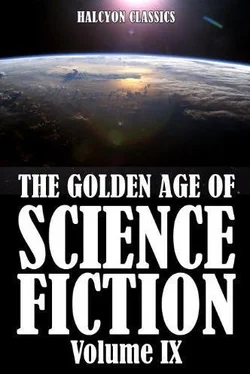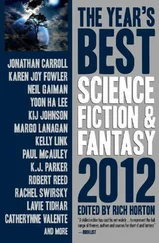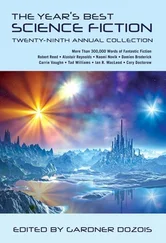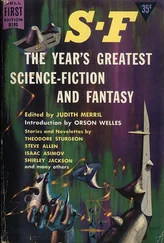“Eastward and northward of these ranges is the Sea of Showers, on which there are several fine ring-mountains and walled plains—notably Autolychus and Aristillus, two very perfect ring-mountains some 9000 feet high.
“One of the most striking, on account of its size and situation, is that large one which is called Archimedes, and is about fifty miles in diameter; and you will notice that a rugged mass of mountains and high hills extends from it to a distance of over a hundred miles on the south. The floor of this walled plain is only about 600 feet below the general level, and the mountain walls average about 4000 feet in height; but there is at least one peak some 7000 feet high.
“You will see a little below and westward of Archimedes the commencement of a system of large cracks or crevasses in the lunar surface which are known as ‘rills.’ Many such systems are found in various parts of the moon; some of the cracks are comparatively shallow, but, according to Professor Langley, others are known to be at least eight miles deep, and may be infinitely deeper, though I cannot say I understand how these great depths have been arrived at. The length of the cracks varies from a few miles to over three hundred miles, and from a few hundred yards to some miles in width. They are attributed partly to volcanic action, but mainly to the contraction of the crust of the lunar globe as it became cold. Being so much smaller, the moon would cool much more rapidly than the earth, and the disruptive effects would necessarily be greater.”
John here touched my arm, and pointing to some mountains on the borders of a large elongated oval area, close to the north-western terminator where the sun was setting, asked me what they were. I explained that the dark area was known as the Mare Crisium, or Sea of Conflicts, and is possibly the deepest of the large lunar depressions.
“It is about 280 miles long from north to south, and 355 miles wide from east to west, but, owing to its position, the width is seen from the earth very much foreshortened, so that it really looks nearly twice as long as it is wide. It contains an area of about 75,000 square miles, thus being as large as the combined area of Scotland and Ireland, and the five largest northern counties of England. It is surrounded by mountains, some being over 11,000 feet high, reckoning from the dark floor.”
I drew their attention to Proclus—a ring-mountain on the eastern side of this sea—which is about eighteen miles in diameter, and the second brightest of the lunar formations. “From its neighbourhood several bright streaks diverge in different directions, two extending a long way across the dark area, and there is a longer one striking towards the north and another towards the south at an angle of about 120 degrees with each other.
“Seen through the telescope, these ray-streaks often appear very brilliant under a high sun, looking in fact very like electric search-lights; though I notice that the Rev. T.W. Webb has rather curiously remarked that these particular streaks are not very easily seen. Similar ray-streaks, many enormously longer than these, are found in various parts of the lunar surface, but their exact nature and origin has never yet been definitely settled. They only come into view when the sun is beginning to be high up in the lunar sky, and the higher the sun, the brighter the rays appear. Some of the shorter ones are ridges, but this is evidently not the case with the others, for they cast no shadows, as ridges would when the sun is low. Very many radiate from a large ring-mountain called Tycho, in the southern hemisphere; and one of them extends, with some breaks, nearly three thousand miles, passing northward over the Sea of Serenity and finally disappearing on the moon’s north-western edge, or ‘limb,’ as it is termed.
“Professor Pickering assumes that these rays were caused by volcanic dust or other light reflecting material emitted from a series of small craters, and states that they are really made up of a series of short rays placed or joined end to end. What I have observed myself seems to bear out this latter statement; but the opinion I have formed as to their origin differs from the theory of Professor Pickering. It seems to me more probable that the volcanic dust was carried by a strong wind, split up into two or more separate currents by a succession of peaks. The wind currents swept clean the area over which they actually passed, but dust fell or drifted in the lines between the currents. Exactly the same thing may be observed in connection with snow-storms on our earth when accompanied by a high wind. One part of the earth’s surface will be swept clean by the wind current, whilst a long line of the adjoining surface is covered with a thick deposit of snow. I have also noticed that where the ray-streaks impinge upon a mountain, or ring, there is an appearance of spreading out and heaping up of the bright material very much as snow would be spread out or drifted up in similar situations on the earth.”
M’Allister here interrupted with the remark that, when we were approaching the moon, he had particularly noticed that all appearance of the face of the “man in the moon” had vanished. He said he had expected to see that more distinctly as we got nearer.
“That would not be the case, M’Allister,” I answered. “The resemblance to a human face which we see from the earth is caused by the combined effect of the bright and dusky areas on the lunar surface as seen from a distance. The depressed dark areas, which we call seas, form the eyes, nose, and mouth of the face, but when we had approached nearer to the moon the details of the surface configuration stood out so much more distinctly that they entirely obliterated the general effect of the markings as seen from a distance.”
“Professor,” exclaimed John, “I have read that before telescopes were invented it was thought by many that the markings seen on the moon were really the features of our own earth reflected by the moon as in a mirror. Is that correct?”
“Oh yes, John,” I said. “It seems to have been a fairly general belief in many parts of the world, and travellers tell us that, even within very recent times, they have found in some of the more out-of-the-way parts of the world that the same idea is still held by uneducated people!”
Objects of interest being so numerous on the lunar surface we could only give a comprehensive glance at many of them, and as we had so many places to inspect, I now gave M’Allister the order to steer eastward.
He accordingly moved his switches and the Areonal quickly passed over the Sea of Tranquillity, which has an area of 140,000 square miles; then over the Sea of Vapours, a smaller area, parts of which have a dusky green tint, from whence to the northward we had a view over the Sea of Serenity, another deep depression nearly as large as the Sea of Tranquillity, and much of which is a light green colour.
Then we came again to the Sea of Showers, a large “sea” having an area of 340,000 square miles; and, still moving eastward, the great lunar “Ocean of Storms” soon came into view. This covers a very large portion of the eastern and north-eastern part of the moon’s surface, and, with all its bays and indentations, is estimated to be two million square miles in extent.
I, however, again reminded them that, although these areas are termed seas and oceans, no water exists there now, whatever may have been the case in the long distant past. They are now only large depressions, and not often level but intersected by hills, ridges, and even mountains.
As we passed along I called their particular attention to the magnificent “Bay of Rainbows” on the north-eastern coast of the Sea of Showers. “From Cape Laplace (9000 feet high) on the western extremity, to Cape Heraclides (4000 feet high) on the eastern extremity, this great bay is about 140 miles across, the depth of its curvature being over eighty miles. It bears a very strong resemblance to many large bays on our sea-coasts in various parts of the world, but I am not aware of any such bay which is bordered by a mass of such lofty mountains as this is.
Читать дальше












